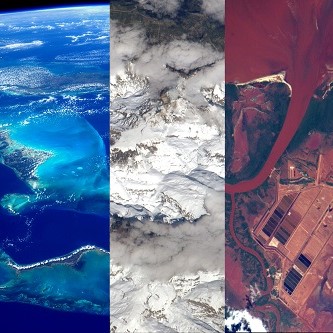It will be radioactive forever. The question is where you put the threshold, which is fairly arbitrary.
Eh, it could be non-radioactive next week. That’s not very likely, but it could be
eh, i could randomly teleport to the moon suddently, but things like theese are unlikely enough to be in effect completely and utterly impossible.
!remindme 101010 universe lifetimes
I could also phase through a wall by sheer coincidence of all my molecules missing the molecules of the wall, but yeah, not going to happen unfortunately
It would imply a significant energy release within a short time in order to become non-radioactive right?
If you only think about half live then yes it would be radioactive forever but in reality after a long time every atom would’ve decayed into non radioactive elements.
You can even calculate the expected time it would take for the random process of decay to terminate.
“after a long time” - that is exactly my point. Where do you draw the line? It will never be non-radioactive, which the headline suggest would be the case in 1’500 years. As far as we know, everything might decay after some time. It will always have some Radon get trapped in it. Scatter some cosmic rays. Blablabla.
By that logic, everything withing a few kilometers of the surface is radioactive, especially all life. That’s not a useful definition of radioactive.
Hence my post, the relevant metric is “how much”, not “if”.
I wonder how long it would take for the radioactivity to be indistinguishable from the atmospheric average.
Is there a way to de-radioactivize it faster?
Marie Curie’s notebooks are still radioactive due to the presence of radium-226, which has a half-life of about 1,600 years. To make her notebook non-radioactive or significantly reduce its radioactivity, the following methods could theoretically be used:
-
Chemical Removal or Neutralization:
- Chemical Extraction: This involves using chemicals to extract the radioactive elements from the paper. This process would be complex and potentially damage the paper.
- Neutralization: This would involve converting the radioactive materials into stable, non-radioactive elements. However, there are no practical methods currently available for neutralizing radium in situ.
-
Encapsulation:
- Instead of making the notebook non-radioactive, it could be permanently encapsulated in a material that blocks radiation, such as lead-lined containers or specialized glass. This wouldn’t make the notebook safe to handle without protection, but it would contain the radiation.
-
Decay Time:
- Given the long half-life of radium-226, waiting for the radioactivity to decay to safe levels is impractical since it would take thousands of years for the radioactivity to diminish significantly.
-
Advanced Radiation Mitigation Techniques:
- There are experimental methods like targeted transmutation, where the radioactive elements are bombarded with particles to induce decay into stable elements. This is highly theoretical and not feasible with current technology for something as delicate as a notebook.
Practically, due to the historical and scientific value of Marie Curie’s notebooks, they are preserved and stored in controlled environments where they can be studied safely using appropriate radiation protection measures. The best approach currently is to handle and store them with care rather than attempting to decontaminate them.
You should preface a comment if you used AI to write it
You’re right. I was being lazy, but I will edit to let people know.
Yes, everyone with some common sense hate LLM generated texts.
-
“Just remember, don’t put your tubes in your pantaloon”
There’s a couple of YouTube videos where urban explorers re-visited Chernobyl many years after the accident. They explored the area around the plant and visited the hospital where Russian firefighters were taken after they were exposed to debris from the reactor’s core.
Their clothing was seriously contaminated and was removed and stored in a room in the hospital’s basement. The explorers visited the basement where the clothing is still stored today. They didn’t get close to the clothing because it is still contaminated. As in, “not safe to enter the room” contaminated.
It should be noted that big chunks of radioactive materials are generally safe same with just generally high radiation under a certain threshold, we are illuminated by a big ball of fuck you radiation after all. The problem is radioactive dust and particulates, once its in your body you are fucked and its pretty random on what amount will kill you. This is what happened to those Russian dumbasses who dug trenches around Chernobyl, they breathed in radioactive dust and it wreaked havoc on their bodies. This is also one of the main reasons you wear gas masks around such things.
If it’s an alpha or beta emitter, sure, you’re probably fine standing near it. But if you find yourself next to a chunk of a gamma emitter, you should probably run away very quickly
But I want to be big green and smash.
🎶Welcome to the new age, to the new age , la la la la🎵🎶
It looks like they were super lazy and took the half life of the longest lived isotope of radium (226 — approx 1600 years) minus its age (approx 100 years) to get to 1,500 years.
I’m guessing we don’t know the particulars of what radium isotope Curie was working with?
How is Chernobyl safe for wildlife now, but this book is still dangerous?
Chernobyl was made into a TV show while this book appears to be just a book.
So if we make a movie about this book then it can be handled again? Or does it have to be a full 10 hour show?
Different radioactive materials have different half-life periods.
Chernobyl isn’t safe safe, it’s just safe enough for wildlife to survive there, possibly with lowered life span and quality of life.
Also, there’s a decent danger of radioactive dust coming off the book if it’s handled. It may not be that radioactive, but if it clings to you, or you breathe it in, it will do considerably more damage than if it was all one solid rock that made geiger counters click.
fun fact: the other three reactors in Chernobyl were put in operation again AFTER reactor 4 blew up
I believe the last one for 14 additional yearshow safe that was is another question though
I think we can safely say with hindsight, it was very safe. Reactor 4 was caused by a fluke of circumstances and a few mistakes. It was otherwise a very safe reactor. Once they understood the failure they are able to adjust protocol to ensure it doesn’t happen again. It made the other reactors even safer.
The same thing happened with three mile island. Unit 1 safely continued operation until 2019, which only stopped because of financial pressures (competition with Methane), not because anything was wrong.
I mean, RBMK based reactors are still in use today, no?
It isn’t “safe” it’s “safe enough” for limited visits to the exclusion zone and VERY limited visits to the sarcophagus that enclosed the old reactor
So what about the animals around there? Are they all dying from radiation poisoning, or turning into Godzilla, or something?
I was gonna answer that most animals don’t live as long and reproduce faster than humans (so populations survive despite increased cancer risk), but when I looked into it I found a deep rabbit hole. In the case of wolves, I’m sure plenty died early on, because the populations present appear to have some genetic immune adaptations that protect them from cancer. I know other species (like frogs) have dark skin because the melenin increased the survival rate of the darker frogs at the time of the accident. So that is to say probably a lot of wildlife died, and that natural selection lead to some critters that are pretty resistant to radiation.
Wow, that’s actually really cool! Not the dying part, but the adapting part. Thanks for sharing!
they didn’t say the book is dangerous, they said it’s radioactive
Um, Chernobyl is still extremely radioactive. You probably mean the exclusion zone which is really not that bad, there’s even tourists going there. But it’s still not recommended to live there due to cumulative exposure.
Interesting video on Chernobyl and the people still living in the exclusion zone.
https://www.bbc.com/travel/article/20140116-cooking-in-the-danger-zone-chernobyl
I can’t watch the video via the BBC site but it exists elsewhere.
Thanks!
So the site itself is still deadly, but the areas around it are not? Would that be the case for a nuclear attack as well? Like ground zero would stay deadly but the rest of the city would be safe a few decades later? I just realized that I don’t actually know very much about nuclear fallout. How are Hiroshima and Nagasaki safe?
Generally the really nasty gamma emitting fission products lose their nastiness after a couple of months. Their half lives tend to be counted in hours.
Complex topic. It would depend on the bomb in question. Some are more “dirty” than others.
It’s been a couple of decades since I watched the documentary so maybe my memory is betraying me but from what I remember the bombs dropped on Japan didn’t touch the ground. They detonated in the air so there technically isn’t a ground zero.
The clouds of radioactive gases carry radiated dust particles that are carried by winds and settle on the ground, roofs, etc (fallout). That’s why after Chernobyl or the Japanese cities were attacked it was very important which way the wind was pushing the clouds carrying the tiny debris, ash, and dust and how the Chernobyl disaster was detected by other countries in the path.
You probably also want to avoid trying to grow any crops in the area because one way to deal with the radioactive dust is to bury it under the top soil, and buildings that have been closed since Chernobyl that still have the dust trapped inside are still very dangerous.
They overturned the dirt in the exclusion zone to bury the fallout so that it’s less of a possibility for it to move around. You wouldn’t want to live there, drink from the groundwater, farm there, etc.
Marie Curie studied radioactivity with pure and very active materials with no protection. The radioactivity of the notebook is indirect radioactivity, that is material that becomes radioactive after being exposed to powerful ionizing radiations. It must be noted that the notebook may not be deadly radioactive. And if it will be for 1500 years, it won’t be deadly for 1500 years. For reference, bananas tend to be radioactive too. And you are exposed to ionizing radiations when you take the plane.
Chernobyl had two reactors burn iirc. Most of the radioactive material was in the reactor, but the fire made smoke out of radioactive materials. The quantity of smoke, in kg, that go out was significant, but it got diluted in the atmosphere and spread. Which means there wasn’t so much dust, in mass, that got in any one place. The dust is also not only uranium, but a combination of uranium and materials that were contaminated like the notebook. With the rain, the dust was washed and distributed more, and with the time, materials become less and less radioactive.
Both the book and chernobyl are not dangerously radioactive. But because of the nature of radioactivity, care must always be taken.
Ionizing radiation can’t produce secondary radioactivity in materials…
Well, maybe explain my confusion then, instead of being an ass.
So there’s four types of radiation: alpha, beta, gamma, and neutron. When you’re talking about radioactive materials, it’s almost exclusively the first three. In addition to the inherent danger of the object itself, there’s also the danger of radioactive contamination: not making other things radioactive, but shedding bits of themselves as dust and then that dust getting on other things, or getting ingested/inhaled by humans.
Active fission reactions, like what goes on in the core of a nuclear reactor (or perhaps messing around with some plutonium and a screwdriver), produce neutron radiation. Neutrons can make other things radioactive, via a process called “neutron activation”, whereby the neutrons bind to the material and change some of the atoms into radioactive isotopes.
I hope that helps, and feel free to ask me anything else about radiation. I have some education about it thanks to my job, and I’m always happy to help other people understand it more as well.
Ha ! Turns out I’m right after all : radioactivation can happen with all type of radiations. But neutron activation is the lowest energy one.
You are right that it’s probably a contamination for the book though, and not directly an activation (although carbon can be activated and will be found in the book).
The thing you said that someone disagreed with was calling it ionizing radiation, which is a more general term and describes radiation with enough energy to ionize an atom or molecule, which means stripping off at least one of its electrons. That requires a lot less energy than activating nuclei in an element that is not radioactive to radioactivity. UV light and X-rays are both ionising radiation, but are not from radioactivity and cannot induce radioactivity. Of course a lot of radioactive radiation (α, β, γ) is also too low-energy to activate more nuclei. It depends on the energy of the radiation and the specific element you’re trying to activate (how close it is to being radioactive, so to speak).
So like CommissarVulpin said - the real danger is more likely to be contamination
Thanks for the great answer!
They’re contaminated, not neutron activated. The curies didn’t get to the point of developing an unshielded nuclear reactor that would sufficiently neutron activate their stuff. They just liked to carry around radium and polonium which also have decay products that themselves are radioactive and they contaminated everything.
Thanks for the precision. Still, the result is the same I’m sure.
More or less. The difference is that, if they really wanted to, they could very thoroughly clean the notebook and take most of the contamination off. I’m guessing they won’t because a) It’s a historical artifact and they don’t want to risk damaging it, b) the contamination is so low-level that it’s not dangerous as long as you don’t lick it or something, and/or c) there’s a bit of a shock factor in watching a scientist’s notebook make a Geiger counter freak out.












